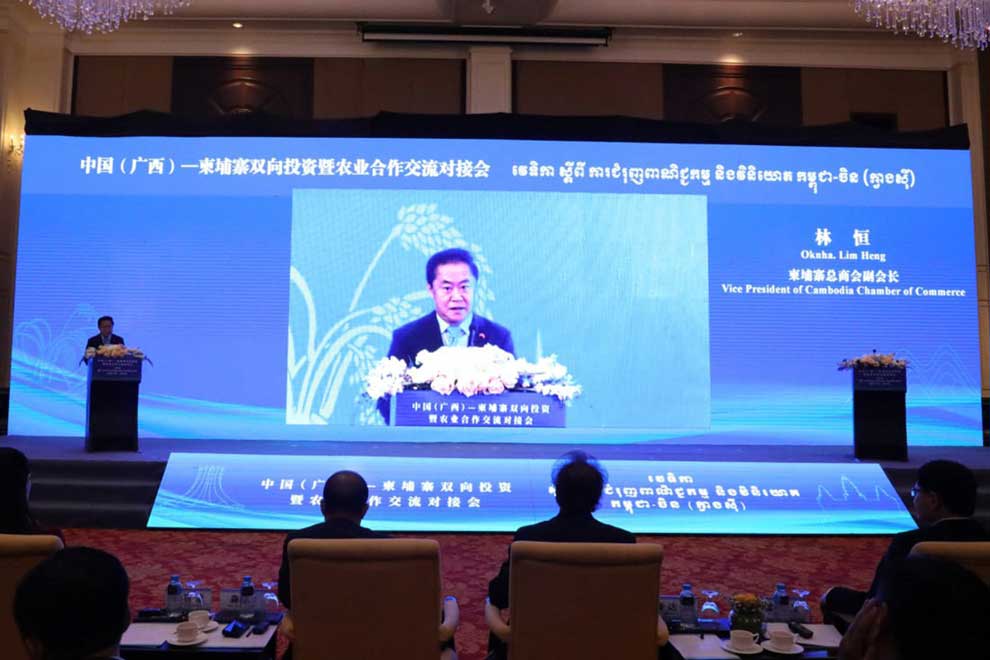
CCC vice-president Lim Heng speaks at a Cambodia-China business event focused on the Guangxi Zhuang Autonomous Region, on April 24. PHOTO SUPPLIED
Numbers of Chinese investors in – or expressing interest in – Cambodia have been on a steady climb, and the Kingdom is armed with a bilateral free trade agreement (FTA) with China and similar deals with other countries, as well as preferential market access to many economies, businesspeople and economists have said.
In an interview with The Post on April 24, Cambodia Chamber of Commerce (CCC) vice-president Lim Heng commented that improved relations between the Cambodian and Chinese governments have drawn the attention of Chinese investors and tourists to Cambodia, and motivated many a trip to the Kingdom.
He attributed the uptick in Chinese investors in the Kingdom to FTAs – namely the bilateral treaties with China and South Korea as well as the Regional Comprehensive Economic Partnership – along with incentives provided by the new Law on Investment, and preferential tariffs for exports to the US, EU and UK.
“The number of Chinese companies and enterprises coming to do business in Cambodia has increased steadily and in almost every sector,” Heng said, noting that the two countries have agreed to develop a “diamond cooperation framework” to supplement their “iron-clad friendship”.
Additionally, the local private sector has opened business centres in major Chinese cities to attract players to the Cambodian market, he noted, highlighting infrastructure construction, agro-processing and agro-industry, mineral resources and electrical and electronic components manufacturing as major areas of focus for Chinese investors in the Kingdom.
“Many Chinese companies are starting to look for post-Covid-19 investment opportunities in the Cambodian agri-processing industry,” he shared, voicing optimism that a visit by a delegation of leaders from China’s southwestern Guangxi region last week would lead to greater awareness of the Kingdom’s investment potential among Chinese businesspeople.
An agreement to develop a “diamond cooperation framework” between the two countries was made on February 10 at a meeting between Chinese President Xi Jinping and Prime Minister Hun Sen in Beijing during the latter’s February 9-11 state visit.
The framework is based on six priority areas: political cooperation, production capacity and quality, agriculture, energy, security, and people-to people exchanges.
Hong Vanak, director of International Economics at the Royal Academy of Cambodia, asserts that “good cooperation” between the two governments has injected a lot of “brightness” to the Cambodian economy, underpinned by China’s crucial supply of raw materials for production.
The Kingdom’s favourable political conditions, investment laws and geographical location – near China – have captured the interest of copious amounts of Chinese investors, he said.
Chinese investors are important contributors to Cambodia’s economic development, Vanak said, predicting that numbers will trend up for the foreseeable future.
Largest investor
According to the central bank, foreign direct investment (FDI) inflows in the Kingdom in the 10,011-day period from the August 5, 1994 promulgation of the old Law on Investment and December 31, 2021 amounted to 168.8 trillion riel ($41.0 billion), rising by 11.2 per cent from the nearly 152 trillion riel recorded by end-2020.
The Greater China region – comprising mainland China, Hong Kong, Macau and Taiwan – accounted for the lion’s share at $18.0 billion or 43.9 per cent, followed by South Korea ($4.9 billion; 11.9%), Singapore ($2.7 billion; 6.5%), Vietnam ($2.5 billion; 6.1%), Japan ($2.4 billion; 5.9%) and Malaysia ($1.9 billion; 4.6%).
Customs (GDCE) statistics show that mainland China again emerged as Cambodia’s largest merchandise trading partner in 2022, with a record full-year volume of $11.686 billion – up 4.39 per cent against 2021 – representing 22.291 per cent of the Kingdom’s $52.425 billion total international merchandise trade for the year.
The Chinese mainland was the largest exporter to Cambodia last year, with a 34.89 per cent share at $10.446 billion – rising 7.86 per cent over 2021. The region also accounted for 5.52 per cent of the Kingdom’s total exports, at $1.241 billion – dipping 17.85 per cent – putting it behind only the US ($8.969 billion) and Vietnam ($2.169 billion).
The Kingdom’s trade deficit with mainland China expanded by 12.61 per cent, from $8.174 billion in 2021 to $9.205 billion in 2022, GDCE figures indicate.
In the first quarter of 2023, the two-way merchandise trade volume came to $2.862 billion, down 0.38 per cent on an annual basis. Cambodian exports to and imports from mainland China were to the tune of $328.646 million and $2.534 billion, respectively, up 2.13 per cent but down 0.70 per cent.
This narrowed the Kingdom’s trade deficit with its top trading partner for the three-month period by 1.11 per cent on an annual basis to $2.205 billion, from $2.230 billion.
The breakdown
No breakdown was immediately available of the specific items traded between Cambodia and mainland China for any interval during the 2022-2023 period.
However, Trading Economics statistics show that, out of Cambodia’s $1.51 billion worth of goods exports to mainland China in 2021, “furskins and artificial fur, manufactures” made up the lion’s share at $404.87 million, followed by “cereals” ($182.29 million), “edible fruits, nuts, peel of citrus fruit, melons” ($176.68 million), and “articles of apparel, knit or crocheted” ($119.46 million).
For reference, the four categories respectively correspond to chapters 43, 10, 8 and 61 of the Harmonised System (HS) of Tariff Nomenclature.
Similarly, out of Cambodia’s $9.68 billion worth of goods imports from mainland China in 2021, “knitted or crocheted fabric” accounted for the most at $1.81 billion, followed by “manmade staple fibres” ($857.54 million), “machinery, nuclear reactors, boilers” ($757.34 million), and “electrical, electronic equipment” ($736.63 million).
These four categories correspond to chapters 60, 55, 84 and 85 of the HS.




















